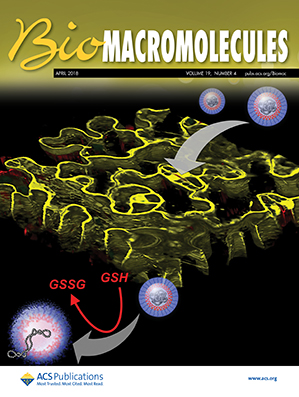Hyperstable and Fibril-Forming Collagen-Mimetic Peptides in Shortest Triple Helices: Empowering the Capping by π‑systems
IF 5.4
2区 化学
Q1 BIOCHEMISTRY & MOLECULAR BIOLOGY
引用次数: 0
Abstract
Developing collagen-mimetic peptides (CMPs) with short triple helices and fibril-forming ability remains challenging. Herein, we stabilized short CMPs (3–6 GPO repeats) by attaching extended aromatic π-systemfluorenyl groups at the N-terminus and tyrosine at the C-terminus. These modifications promoted triple helix folding through π–π interactions, acting as a “glue” to stabilize the structure and facilitate fibrillation. A single fluorenyl cap required 5 GPO repeats for helix formation, while double fluorenyl capping reduced this to 4 repeats. Notably, at pH 5.5, triple helices formed with only 3 GPO repeats. The double-capped CMPs exhibited hyperstability (T m = 76 °C) and formed fibrillar networks at physiological pH. Biophysical and computational studies confirmed the role of π–π and CH–π interactions, along with hydrogen bonding, in stabilization. The minimalistic CMPs supported cell viability, demonstrating their potential for biomedical applications. This strategy offers a method to design highly stable, short CMPs that form robust fibrillar networks.
- Download: Download high-res image (150KB)
- Download: Download full-size image
在最短的三螺旋中形成超稳定和纤维状的模拟胶原肽:π-系统赋予其封顶能力。
开发具有短三螺旋和原纤维形成能力的模拟胶原肽(CMPs)仍然具有挑战性。在此,我们通过在n端和c端分别连接扩展的芳π体系氟烯基和酪氨酸来稳定短的CMPs(3-6个GPO重复序列)。这些修饰通过π-π相互作用促进了三螺旋折叠,就像“胶水”一样稳定结构并促进纤维性颤动。单个氟烯基盖帽需要5个GPO重复才能形成螺旋,而双氟烯基盖帽将其减少到4个重复。值得注意的是,在pH 5.5下,只有3个GPO重复序列形成三螺旋。双帽CMPs表现出超稳定性(Tm = 76°C),并在生理ph下形成纤维状网络。生物物理和计算研究证实了π-π和CH-π相互作用以及氢键在稳定性中的作用。简约的cmp支持细胞活力,展示了它们在生物医学应用方面的潜力。这种策略提供了一种设计高度稳定、短的cmp的方法,可以形成强大的纤维网络。
本文章由计算机程序翻译,如有差异,请以英文原文为准。
求助全文
约1分钟内获得全文
求助全文
来源期刊

Biomacromolecules
化学-高分子科学
CiteScore
10.60
自引率
4.80%
发文量
417
审稿时长
1.6 months
期刊介绍:
Biomacromolecules is a leading forum for the dissemination of cutting-edge research at the interface of polymer science and biology. Submissions to Biomacromolecules should contain strong elements of innovation in terms of macromolecular design, synthesis and characterization, or in the application of polymer materials to biology and medicine.
Topics covered by Biomacromolecules include, but are not exclusively limited to: sustainable polymers, polymers based on natural and renewable resources, degradable polymers, polymer conjugates, polymeric drugs, polymers in biocatalysis, biomacromolecular assembly, biomimetic polymers, polymer-biomineral hybrids, biomimetic-polymer processing, polymer recycling, bioactive polymer surfaces, original polymer design for biomedical applications such as immunotherapy, drug delivery, gene delivery, antimicrobial applications, diagnostic imaging and biosensing, polymers in tissue engineering and regenerative medicine, polymeric scaffolds and hydrogels for cell culture and delivery.
 求助内容:
求助内容: 应助结果提醒方式:
应助结果提醒方式:


